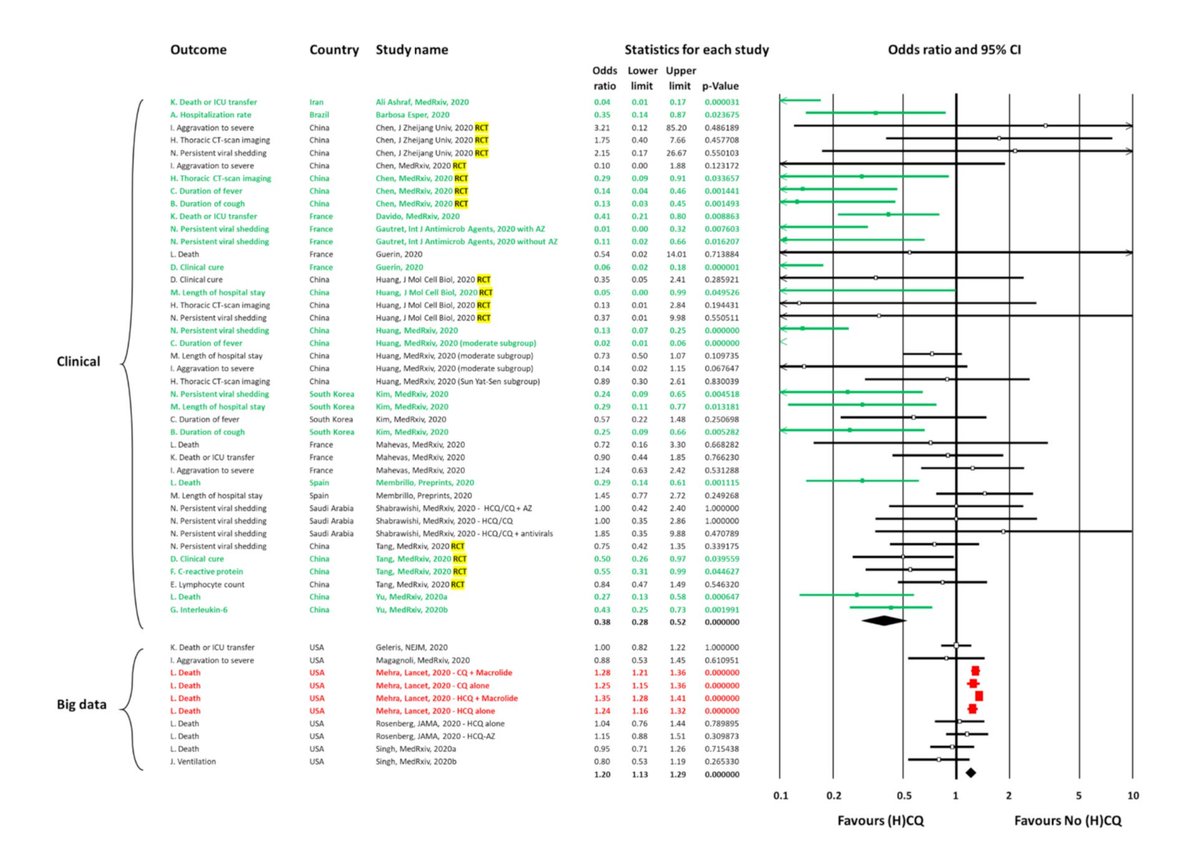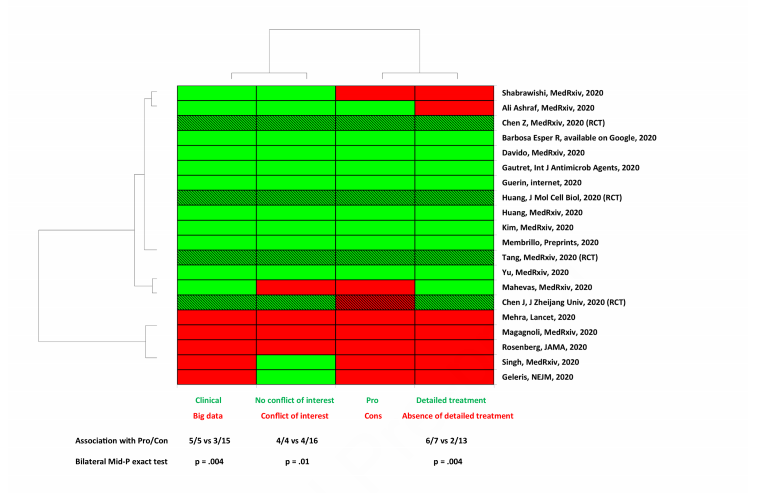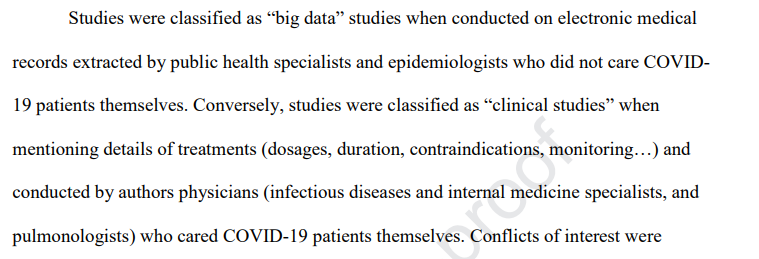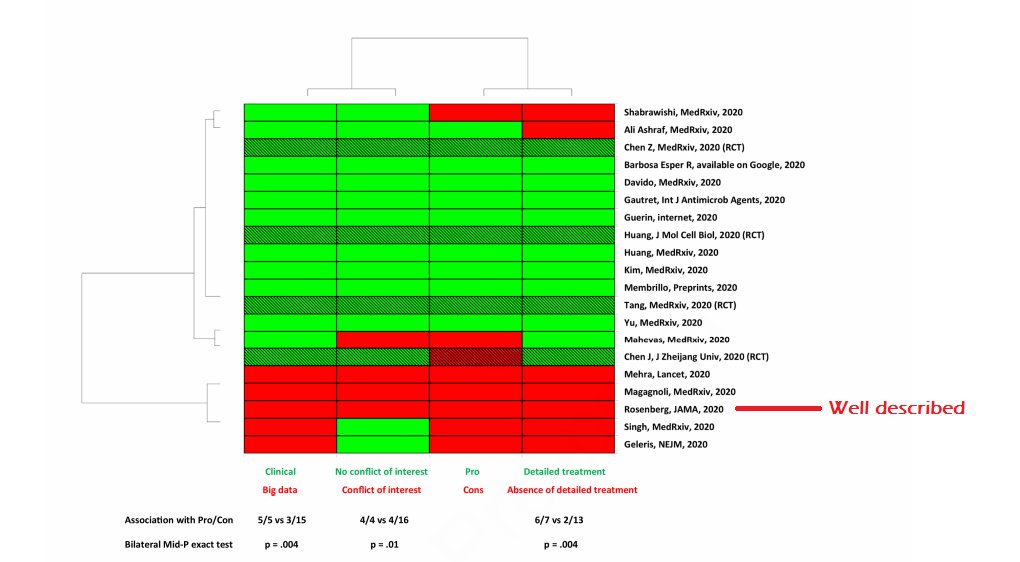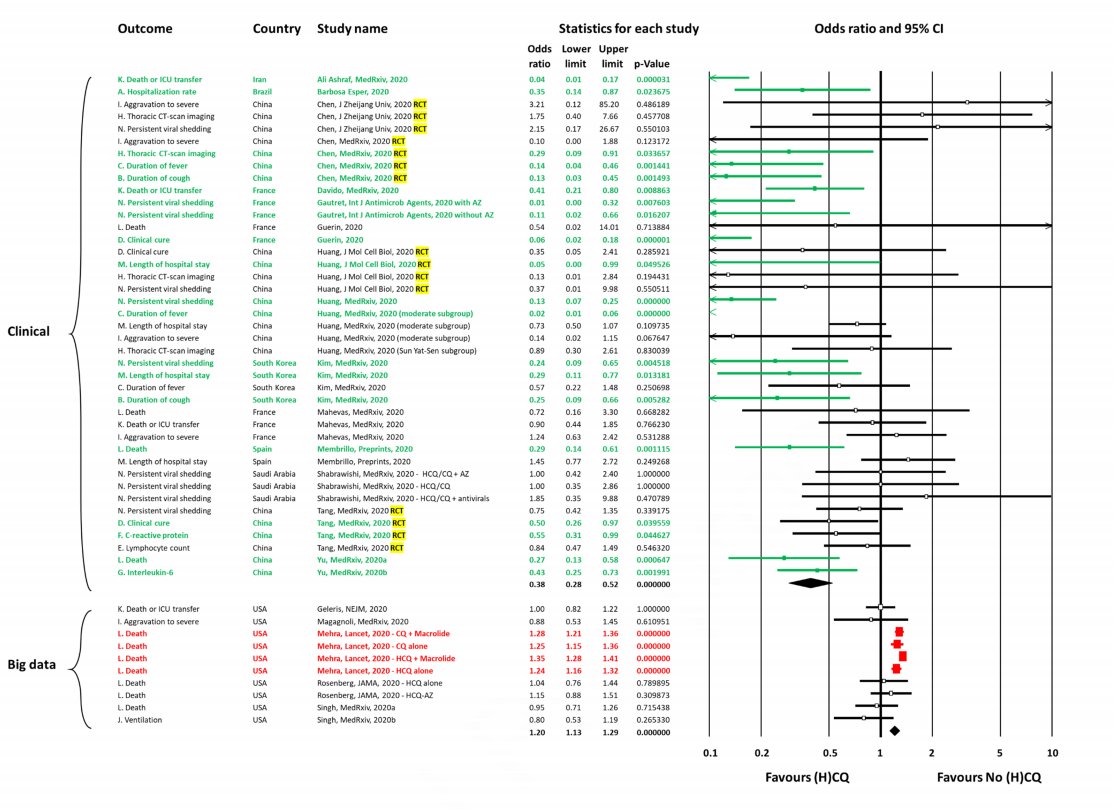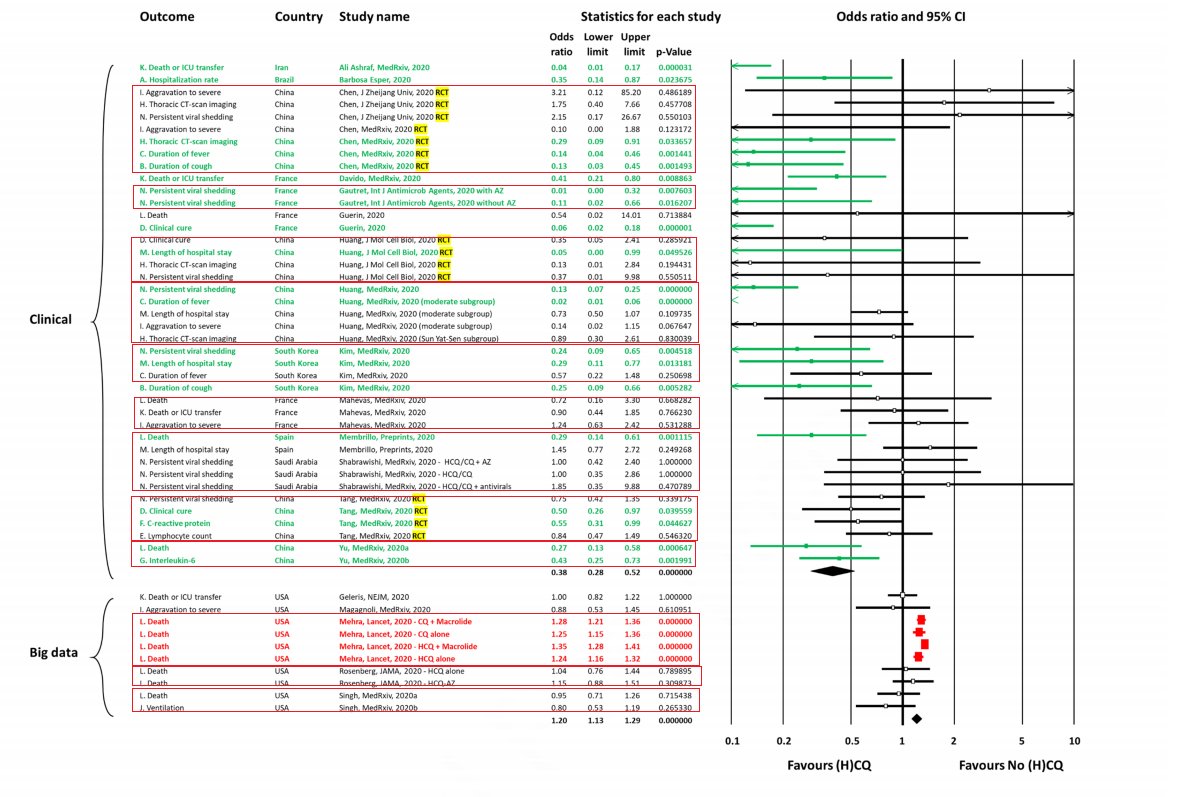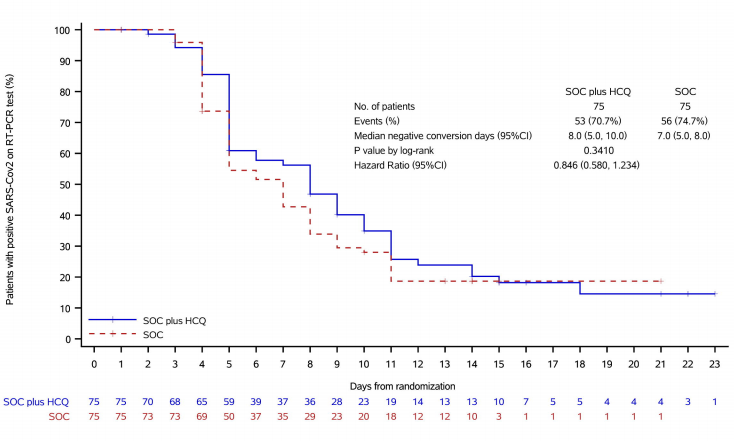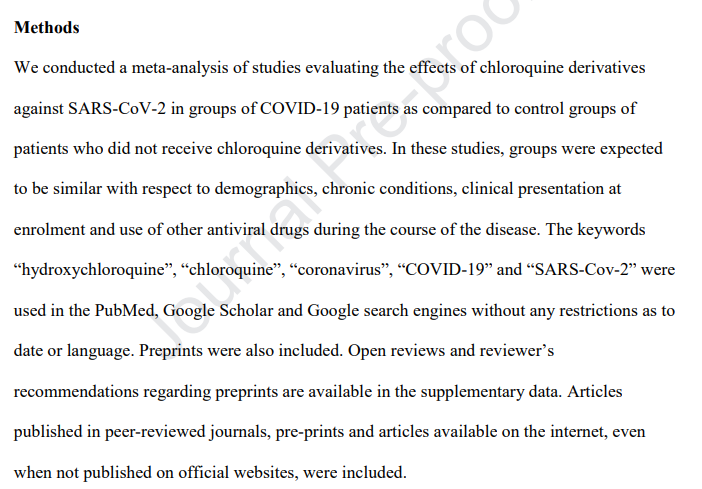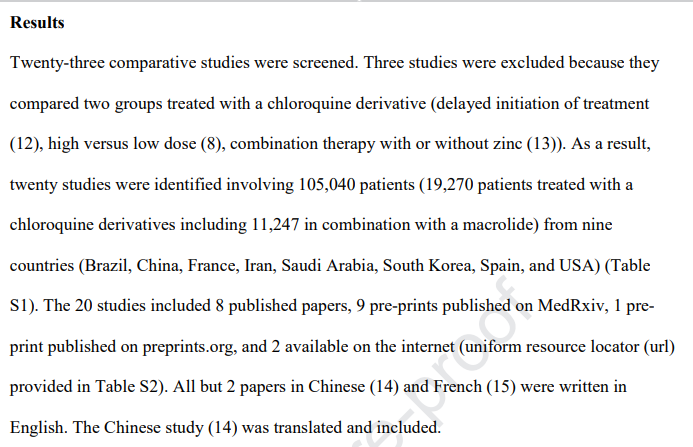Ok, I& #39;m inspired by @MicrobiomDigest to do a bit of actual critical appraisal on this new paper by Raoult et al
There are significant issues that in my opinion make it basically worthless as an estimate of anything 1/n https://twitter.com/GidMK/status/1270163967634096128">https://twitter.com/GidMK/sta...
There are significant issues that in my opinion make it basically worthless as an estimate of anything 1/n https://twitter.com/GidMK/status/1270163967634096128">https://twitter.com/GidMK/sta...
2/n You can find the paper here: https://www.sciencedirect.com/science/article/pii/S2052297520300615?via%3Dihub">https://www.sciencedirect.com/science/a...
3/n The study is a fairly simple review and meta-analysis looking at hydroxychloroquine/chloroquine for COVID-19
This means the authors looked through the literature, and aggregated a bunch of different estimates of the impact of HCQ/CQ on health from different studies
This means the authors looked through the literature, and aggregated a bunch of different estimates of the impact of HCQ/CQ on health from different studies
4/n The authors (who have previously maintained that HCQ works for the disease) perhaps unsurprisingly found that, when you lumped all the evidence together, HCQ/CQ was beneficial for COVID-19
5/n Now, the authors have said publicly that meta-analyses are the most robust form of evidence thus this is the final answer on the question
That& #39;s not precisely true - meta-analyses are only as good as the included research!
That& #39;s not precisely true - meta-analyses are only as good as the included research!
6/n So, we want to know how good the included studies are
Fortunately, the authors have created a bias rating system for us. Excellent
Fortunately, the authors have created a bias rating system for us. Excellent
7/n On closer inspection, however, this bias rating system makes absolutely no sense and is clearly not applied systematically even within the document
8/n For example, studies were rated down if they were "Big Data", which in this case appears to have almost entirely been a judgement call based on how much clinical work each study& #39;s authors do
9/n So, for example, a retrospective analysis of routinely collected data was rated down because it was lead by a public health physician, but another almost identical piece of work was given a green square because a pulmonologist was in charge  https://abs.twimg.com/emoji/v2/... draggable="false" alt="🤔" title="Denkendes Gesicht" aria-label="Emoji: Denkendes Gesicht">
https://abs.twimg.com/emoji/v2/... draggable="false" alt="🤔" title="Denkendes Gesicht" aria-label="Emoji: Denkendes Gesicht">
10/n The "detailed treatment" rating was similarly biased - many of the green studies in this chart had far worse descriptions of the treatment regimen than the JAMA study, which is red
11/n There is also a column detailing which studies have rated HCQ/CQ as beneficial or not, which definitely shouldn& #39;t be included in a risk of bias segment
This is INCREDIBLY misleading
This is INCREDIBLY misleading
12/n Moreover, there is basically no discussion of how the final measure - conflict of interest - was actually collated. It wasn& #39;t from the disclosures on the studies (I checked)
13/n So, all in all, the rating of the studies makes very little sense and is at best entirely inconsistent. It& #39;s hard to know what to make of this except that it doesn& #39;t help us understand the included research at all
Moving on
Moving on
15/n Firstly, different results from THE SAME studies on THE SAME patients have been aggregated together
This is guaranteed to bias the results, and makes the aggregated estimate largely worthless
(red box = repeated)
This is guaranteed to bias the results, and makes the aggregated estimate largely worthless
(red box = repeated)
16/n (N.B. some of these estimates are not the SAME patients, they are different groups from the same study. This is also bad practice, and likely to bias the estimate, but not quite as problematic)
18/n Now, the authors report very opaquely on how they derived the odds ratios that are used in this table (essentially "we plugged it into the software"), but some of these figures are enormously divergent from the actual reported outcomes
19/n For example, let& #39;s look at this preprint that was included in the research
The odds ratio for "Persistent viral shedding" is 0.75 (0.42-1.35), with lower values favoring HCQ/CQ
I.e. 25% LOWER odds of persistent viral shedding for HCQ
The odds ratio for "Persistent viral shedding" is 0.75 (0.42-1.35), with lower values favoring HCQ/CQ
I.e. 25% LOWER odds of persistent viral shedding for HCQ
20/n But if we look at the paper, this doesn& #39;t make sense
Of the HCQ group, 22/75 had a persistent viral load
Of the control, it was 19/75
If you work the odds ratio out, you get 1.22, i.e. 22% HIGHER FOR HCQ
Of the HCQ group, 22/75 had a persistent viral load
Of the control, it was 19/75
If you work the odds ratio out, you get 1.22, i.e. 22% HIGHER FOR HCQ
21/n In other words, not only is the figure in the meta-analysis wrong, it seems to be in entirely the opposite direction to the true result
That& #39;s very worrying, and hard to explain
That& #39;s very worrying, and hard to explain
22/n (One thing that gives you an answer more similar to the number they& #39;ve got is calculating odds based on the %s given in the KM curve rather than the crude figures, but that has its own issues)
23/n There& #39;s also no reasoning given for including multiple different outcomes from the SAME PATIENTS in a meta-analysis
This is very concerning
This is very concerning
24/n For example, they& #39;ve got some studies where they included numbers on the likelihood of a "clinical cure" AND "death" from the same patients
These are obviously related, so aggregating both in the same model is...problematic
These are obviously related, so aggregating both in the same model is...problematic
25/n It& #39;s also worth noting that several of these retrospective clinical audits were from the same places at overlapping times, and so probably included some of the same patients anyway
26/n There are, somehow, even more issues to examine here
For one thing, the review protocol was poorly described and hard to follow
For one thing, the review protocol was poorly described and hard to follow
27/n Remember; this is the pre-proof version of the study
In other words, the final, slightly unedited, publishable version
In that context, this methodology is FAR too opaque
In other words, the final, slightly unedited, publishable version
In that context, this methodology is FAR too opaque
28/n The results show you what I& #39;m talking about
There is NO WAY that searching with those search terms gets you only 23 studies
Even just plugging in the search terms to PubMed gives you >100 studies
There is NO WAY that searching with those search terms gets you only 23 studies
Even just plugging in the search terms to PubMed gives you >100 studies
29/n It took me less than 5 minutes to find a study that matches the inclusion criteria but was not included
That& #39;s...worrying
That& #39;s...worrying
30/n On top of that, in some cases the authors have included older versions of the included studies
That& #39;s less than ideal (newer versions CORRECT mistakes!)
That& #39;s less than ideal (newer versions CORRECT mistakes!)
31/n There is so much more I could look at here, but honestly you have to stop somewhere
This study is riddled with flaws and almost certainly does not present an accurate estimate of the effect of HCQ or CQ
This study is riddled with flaws and almost certainly does not present an accurate estimate of the effect of HCQ or CQ
32/n If you want a decent summation of the evidence for/against HCQ, a good source is CEBM:
"Current data do not support the use of hydroxychloroquine for prophylaxis or treatment of COVID-19" https://www.cebm.net/covid-19/hydroxychloroquine-for-covid-19-what-do-the-clinical-trials-tell-us/">https://www.cebm.net/covid-19/...
"Current data do not support the use of hydroxychloroquine for prophylaxis or treatment of COVID-19" https://www.cebm.net/covid-19/hydroxychloroquine-for-covid-19-what-do-the-clinical-trials-tell-us/">https://www.cebm.net/covid-19/...
33/n I forgot to mention, the paper was received, revised, and accepted within a month
While not unheard of, that& #39;s very quick for academic publishing!
While not unheard of, that& #39;s very quick for academic publishing!
34/n In summation, the paper:
- inadequately rates risk of bias
- inappropriately combines estimates...
- ...that may have been miscalculated
It is hard to know what to make of this, except to say that the paper itself is not very useful in any way
- inadequately rates risk of bias
- inappropriately combines estimates...
- ...that may have been miscalculated
It is hard to know what to make of this, except to say that the paper itself is not very useful in any way

 Read on Twitter
Read on Twitter